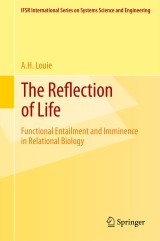Details

The Reflection of Life
Functional Entailment and Imminence in Relational BiologyIFSR International Series in Systems Science and Systems Engineering, Band 29
|
85,59 € |
|
| Verlag: | Springer |
| Format: | |
| Veröffentl.: | 17.04.2013 |
| ISBN/EAN: | 9781461469285 |
| Sprache: | englisch |
| Anzahl Seiten: | 243 |
Dieses eBook enthält ein Wasserzeichen.
Beschreibungen
<p>A. H. Louie’s <i>The Reflection of Life: Functional Entailment and Imminence in Relational Biology</i> is a continuation of the exploratory journey in relational biology which began with his 2009 monograph <i>More Than Life Itself: A Synthetic Continuation in Relational Biology.</i> The theme of his first book was ‘What is life?’; the theme of this sequel is “How do two life forms interact?” Biology is a subject concerned with organization of relations. Relational biology is the approach that advocates ‘function dictates structure”, rather than ‘structure implies function’. It is mathematics decoded into biological realizations. The book demonstrates some of the powers of the approach of relational biology, and illustrates how pertinent problems in biology can be better addressed this way. In the first volume the theory was developed by using partially ordered sets, lattices, simulations, models, Aristotle’s four causes, graphs, categories, simple and complex systems, anticipatory systems, and metabolism-repair [(M,R)-] systems.</p><p> Here in the second volume, these tools are expanded to employ set-valued mappings, adjacency matrices, random graphs, and interacting entailment networks. The theory of set-valued mappings culminates in the imminence mapping, which equips the further investigation of functional entailment in complex relational networks. Imminence in (M,R)-networks that model living systems addresses the topics of biogenesis and natural selection. Interacting (M,R)-networks with mutually entailing processes serve as models in the study of symbiosis and pathophysiology. The formalism also provides a natural framework for a relational theory of virology and oncology.</p><p>This book will serve researchers and graduate students in mathematics and biology.</p><p>
Mapping Origins.- From Points to Sets.- Principles of Set-Valued Mappings.- Censusing Independence.- Set-Valued Mappings Redux.- The Logic of Entailment.- The Imminence Mapping.- Imminence of Life.- Imminence in Models.- Connections.- Symbiosis.- Pathophysiology.- Relational Virology.- Therapeutics.
Dr. Aloisius H. Louie is a mathematical biologist. His 1981 PhD thesis topic was on the abstract formulation of categorical system theory in biology. Robert Rosen, then Killam Professor of Biomathematics at Dalhousie University (Halifax, Nova Scotia, Canada), was his mentor. His other degrees are BSc (1978, Honours Mathematics and Biology) and MA (1979, Pure Mathematics) from the University of Western Ontario (London, Ontario, Canada). Dr. Louie's research subjects have encompassed abstract formulations, mathematical modelling, and computer simulations of various natural and physical phenomena, including dynamic behaviour of protein molecules, enzyme-substrate recognition, processes of irreversible thermodynamics, human-pollutant interactions, the cell biology of senescence, and electromagnetics. His premier interest, however, remains the epistemological aspects of mathematical biology.
<p>A. H. Louie’s <i>The Reflection of Life: Functional Entailment and Imminence in Relational Biology</i> is a continuation of the exploratory journey in relational biology which began with his 2009 monograph <i>More Than Life Itself: A Synthetic Continuation in Relational Biology.</i> The theme of his first book was ‘What is life?’; the theme of this sequel is “How do two life forms interact?” Biology is a subject concerned with organization of relations. Relational biology is the approach that advocates ‘function dictates structure”, rather than ‘structure implies function’. It is mathematics decoded into biological realizations. The book demonstrates some of the powers of the approach of relational biology, and illustrates how pertinent problems in biology can be better addressed this way. In the first volume the theory was developed by using partially ordered sets, lattices, simulations, models, Aristotle’s four causes, graphs, categories, simple and complex systems, anticipatory systems, and metabolism-repair [(M,R)-] systems.</p><p><p><p>Here in the second volume, these tools are expanded to employ set-valued mappings, adjacency matrices, random graphs, and interacting entailment networks. The theory of set-valued mappings culminates in the imminence mapping, which equips the further investigation of functional entailment in complex relational networks. Imminence in (M,R)-networks that model living systems addresses the topics of biogenesis and natural selection. Interacting (M,R)-networks with mutually entailing processes serve as models in the study of symbiosis and pathophysiology. The formalism also provides a natural framework for a relational theory of virology and oncology.</p><p>This book will serve researchers and graduate students in mathematics and biology.</p><p>
Presents further developments in the field of relational biology by focusing on the theme "How do two life forms interact"? Advances the field of relational biology from both a mathematical and a biological point-of-view Introduces "imminence mappings" which facilitate further investigation of functional entailment in complex relational networks Includes supplementary material: sn.pub/extras
Diese Produkte könnten Sie auch interessieren:

Linear and Integer Programming vs Linear Integration and Counting

von: Jean-Bernard Lasserre

96,29 €

Reactive Search and Intelligent Optimization

von: Roberto Battiti, Mauro Brunato, Franco Mascia

96,29 €














